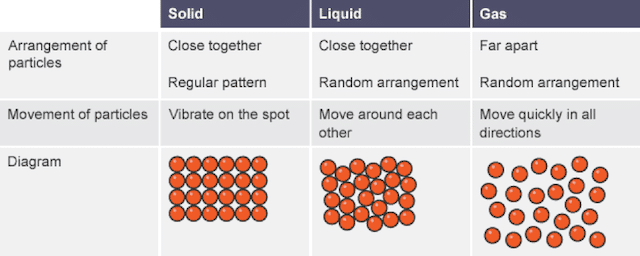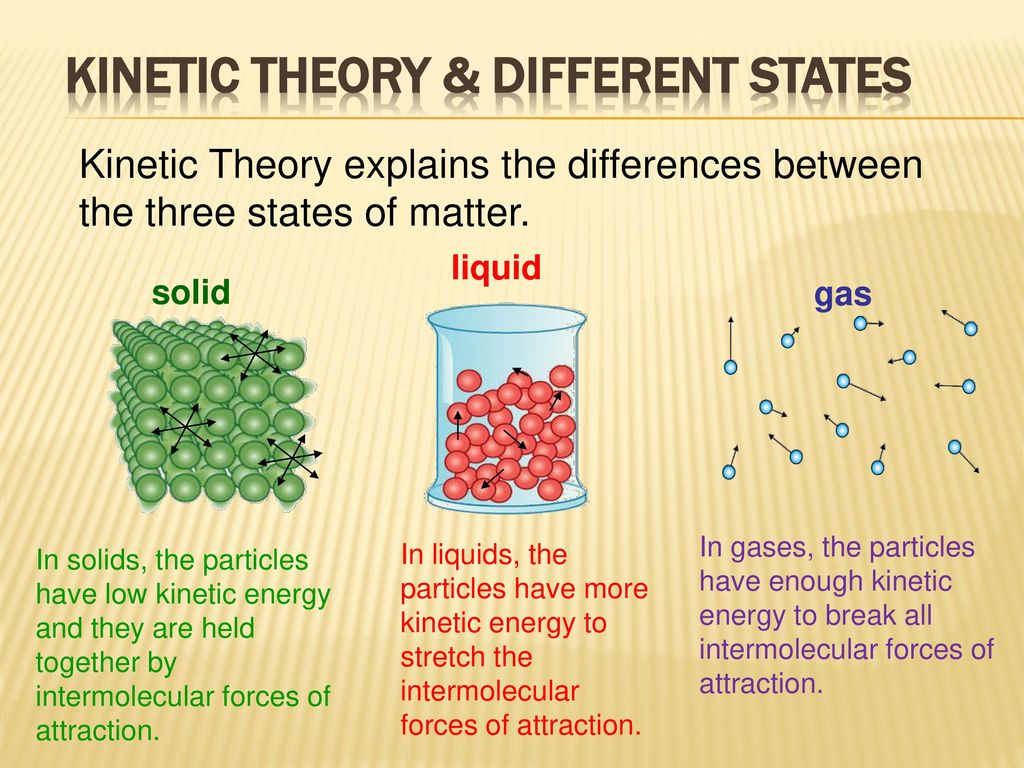We will describe these by their general motion and amounts of kinetic energy as follows. Solid liquid and gas and how matter can change from one phase to another.

Kinetic Energy Attractions Vs Unit 12 States Of Matter Ppt Download
Describe the particle motion of solids liquids and gases.

. What is kinetic energy. Solids Liquids Gases Volume definite or indefinite Molecular Motion high med low Distance Between Molecules g 2. Solid particles have the least amount of energy and gas particles have the greatest amount of energy.
The kinetic molecular theory of matter says that molecules of gases undergo greater rotational translational and vibrational motion than the molecules solids and liquids. In addition you should also describe the shape volume density compressibility and. Describe kinetic molecular theory.
Question 1 1 Poin Why cant the kinetic molecular theory be applied to liquids and solids. B solids liquids and gases. According to the basic assumption of kinetic.
In gases the particles are very far apart and move very fast and freely. The kinetic particle theory explains the properties of solids liquids and gases. Describe how gases liquids and solids compare using the following table.
1 Solids have a definite shape and volume because solids shows that the force of attraction between the entities in the solid are very strong. Describe kinetic molecular theory. The forces between the particles are very weak.
For the use of gas and other meanings see Gas disambiguation. There are energy changes when changes in state occur. Identify each statement as True or False.
3 Identify each statement as True or False. Liquids may be compressed. Identify each statement as True or False.
All solids liquids and gases are types of matter. Kinetic molecular theory is useful in describing the properties of solids liquids and gases at the molecular level. Solids Liquids Gases Volume definite or indefinite Molecular Motion high med low Distance Between Molecules 2 Read p.
C solids and liquids only. Apr 30 2015. Little or no intermolecular forces are involved except in collision.
Now explain how the particles are arranged in a solid a liquid and gas using words. 1 Describe how gases liquids and solids compare using the following table. Through the use of KMT a few different laws have been created to help quantify the relationship between the.
Kinetic Molecular Theory Of Solids Liquid Gas And Solids. 3- Why cant the kinetic molecular theory be applied to liquids and solids. Describe how gases liquids and solids compare using the following table.
What is kinetic energy. C11-1-01 Describe the properties of gases liquids solids and plasma. The particles of a solid will possess only a small amount of kinetic energy.
The force of attraction also is the reason why solids are close together. 2- Identity which of these gases exhibit non-ideal gas behavior. Kinetic Molecular Theory Worksheet 1.
4- Describe how surface area temperature and intermolecular forces are related to the rate of evaporation of a liquid and vapor pressure. Particles are assumes to have a v 0 2. Random motion intermolecular forces.
Solids Liquids Gases Volume definite or indefinite Molecular Motion high med low Distance Between Molecules 2. 32 The kinetic molecular theory ESAAL The kinetic theory of matter helps us to explain why matter exists in different phases ie. Explained using the kinetic particle theory of gases and solids.
Forces between particles are weaker. The kinetic theory of matter also helps us to understand other properties of matter. In your answer you should describe the arrangement separation force of attraction motion and kinetic energy of the particles.
Kinetic theory of matter. Their molecules just move around carelessly for as much space is available. Answer the following questions completely and concisely.
What is kinetic energy. According to the basic assumption of kinetic molecular. The kinetic theory is applicable to gases with low density at high temperatures.
According to the basic assumption. All particles have energy and the energy varies depending on the temperature the sample of matter is in which determines if the substance is a solid liquid or gas. Broadly the kinetic theory of matter says that all matter is composed of particles.
The kinetic-molecular theory explains the behavior of a liquids and gases only. Thats why gases dont have fixed volumes. A change in phase may.
The temperature of a substance is a measure of the average kinetic energy of the particles. After kinetic theory the theories for real gases have been given with large number of empirical inter molecular potential energy functions. Describe kinetic molecular theory.
Use the editor to format your answer Question 2 1 Point Describe the 4 standards that gases need to have in order to. This is when a solid on heating directly changes into a gas without melting AND the gas on cooling reforms a solid directly without condensing to a liquid. Gases always fill the containers into which they are placed.
Density compressibility diffusion C11-1-02 Use the Kinetic Molecular Theory to explain properties of gases. The imaginary gas that obeys all assumptions in kinetic theory of gases is known as ideal gas. In liquids there are larger spaces between particles and the particles move freely.
Kinetic Molecular Theory and Gas Laws. Chemistry questions and answers.

The Kinetic Theory Of Gases Kinetic Energy Of A Molecule


0 Comments